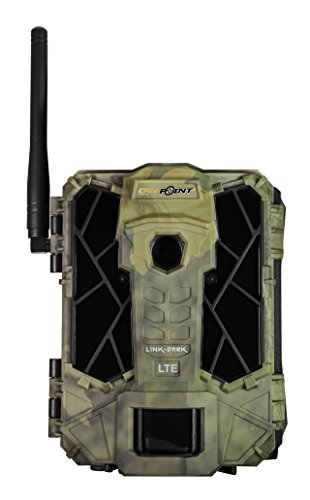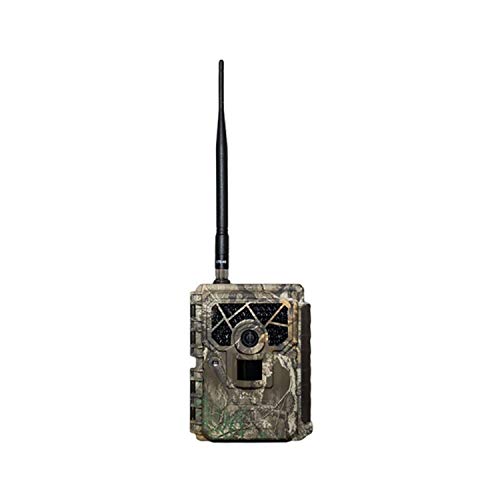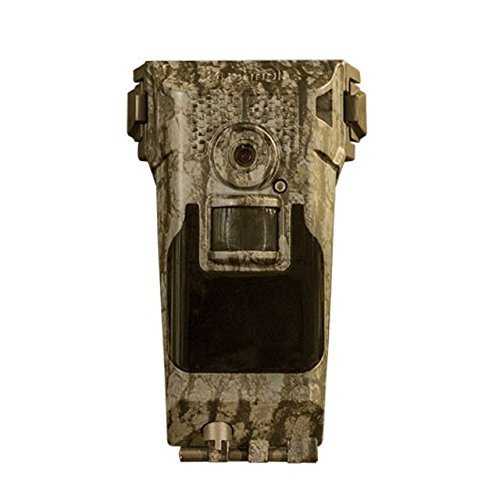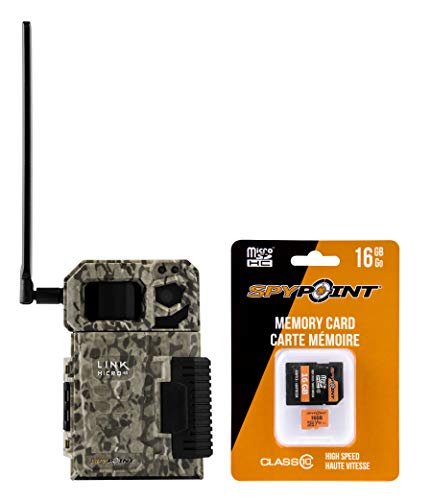Updated December 7, 2020
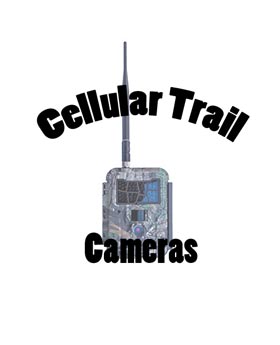
Cellular trail cameras can send you pictures and videos immediately after they are captured. They can allow you to know what is going on in the woods or on your property in real-time, without you needing to physically go check the trail cameras and if you are using them for hunting, without running the risk that you will be scaring the game animals out of your area and contaminating the area with human scent. Thankfully, there are a lot of terrific trail cameras to choose from these days and the prices have really come down from where they were just a few years ago.
Table of Contents
In a Hurry? Here is a List of the Cellular Trail Cameras We Recommend:
- SPYPOINT LINK-DARK & LINK-DARK-V – Great all-around cellular trail camera
- Covert Blackhawk LTE (VERIZON) & Covert Code Black LTE (AT&T) – Great cellular trail cameras for people who like to record videos.
- Cuddeback CuddeLink Dual Cell – Great for people who are considering having multiple cellular trail cameras.
- Bushnell Impulse – Great for people who want a lot of customizable features and for those who like to figure out how the weather affects game movement patterns.
- SPYPOINT LINK-MICRO – Compact cellular trail camera at a great price for people who want to conceal the camera’s location.
Comparison of Cellular Trail Cameras










Is There a Difference Between Cellular and Wireless Trail Cameras?
Wireless Trail Cameras Defined
A wireless trail camera allows you to view the pictures or videos it captures without needing to connect cables to the camera or removing the memory card. Wireless game cameras send these files to your computer or smartphone in one of two ways.
One way that these files can be transferred wirelessly is through the use of Bluetooth technology. These Bluetooth enabled cameras will allow you to connect to the camera with your smartphone or computer via a Bluetooth connection and transfer the pictures and video that way. The one negative about these cameras is that you will still need to be relatively close to them (100 feet or less in most cases) to make the Bluetooth connection and download the files onto your device.
The other way these cameras can transfer information wirelessly is through the use of a Wi-Fi internet connection. Once connected to the internet these Wi-Fi enabled cameras can send you the pictures and videos it captures. One drawback to Wi-Fi enabled trail cameras is that they need to stay within the Wi-Fi range so it can make a connection. Another drawback for Wi-Fi enabled trail cameras is that they will drain your batteries faster if they are always connected to the internet (so you might want to consider a solar panel or battery box for these models).
Cellular Trail Cameras Defined
One way in which cellular trail cameras differ from wireless trail cameras is that they have a much greater range. Instead of needing to keep it within range of a Wi-Fi signal so it can connect to the internet or walking up to within 100 feet or less of the game camera to receive images and/or videos all you need to do with a cellular game camera is to put it in an area that has a strong enough cellular signal so it can make a connection (like your cellphone).
This freedom to post the camera in the areas you are most interested in monitoring means that you can get the information you want and thanks to cellular technology you can get that information when you want it.
Cellular Game Cams are Often Referred to as “Wireless”
Even though wireless technology doesn’t necessarily mean cellular technology most people who use the term wireless trail camera are actually referring to a trail cam that uses cellular technology to send photos and videos.
Note: Because in the trail camera world the terms wireless and cellular are used interchangeably we want you to know that anytime we might use the phrases wireless trail camera or wireless game camera in the rest of this article we are referring to a cellular trail cam.
Cellular Trail Cameras Can Save You Money
On one hand, buying a cellular trail camera might cost you some extra money initially, but in the long run, having a cellular game camera might save you money. For example, the place I prefer to deer hunt is a 4-hour drive away and is accessible only with a truck. After a few trips each fall to check the images on my trail cameras I can spend a couple of hundred dollars in gas each year, which will go a long way to paying for any additional expenses I might have with a cellular deer camera.
Plus, the information I can obtain by having the images of deer and other wild game from my trail camera emailed to me during the season can help me make those critical in-season decisions of where to hunt.
What to Consider When Buying a Cellular Trail Camera
Like all trail cameras, you want to consider image quality, trigger speed, and flash range. You can read our complete buying guide for trail cameras here.
However, there are some additional things you should keep in mind when buying cellular game cameras. These things include:
2G vs. 3G vs. 4G Cameras
Be warned that 2G service is rapidly becoming a thing of the past. If you buy a trail camera that utilizes 2G towers it will no longer be able to transmit pictures when the last of the 2G towers are taken out of service. Once this happens your 2G trail camera will still be able to capture images and video, but it won’t be able to send them to you, which kind of defeats the purpose of having a cellular trail camera. So you probably want to look at a 3G or 4G cellular model.
Most cameras will utilize 3G networks. While 4G cellular networks are growing it is common to find that you will only have a 3G signal in the more remote areas where many of us would be most likely to use a trail camera. So you should feel fine looking at wireless trail cameras that can utilize a 3G network.
Cellular Service Fees (Data Plan)
If you are going to use a cellular trail camera you will need to pay a carrier to have access to their towers and wireless network. The term “data plan” refers to the fees associated with this using a wireless network to transmit images or video. These fees are usually pretty reasonable, but there is obviously almost always cost involved.
Cellular Providers (Carriers)
Many people will only purchase cellular trail cameras that can use the same cellular provider (ex. AT&T, Verizon) that they already use for their cell phones. They do this because they falsely believe that you need to have an existing account with the provider in order for your cellular trail camera to use their wireless network.
The fact of the matter is that you don’t need an existing plan in order for your cellular trail camera to use a cellular network. The cellular providers have separate plans just for your trail camera. So there is no need for you to be a current customer or have a previous business relationship with them. So go ahead and buy the cellular trail camera that best meets your needs.
Cell Coverage
Before purchasing a cellular trail camera you probably want to try and verify that there is a cell signal in the area where you want to place the camera(s). The first thing you can do is look at the carrier’s coverage map.
Most of us have all had the experience of not having a cellular signal even though a coverage map says that we should. So if you are considering purchasing a cellular trail camera that uses the same network that your cell phone is already using it could be helpful to the area you intend on placing the trail camera and verify the signal strength yourself with your cell phone.
The other thing you can do is make sure that you are aware of the return policy and make sure you try the camera out before the policy expires so you have a chance to return it if the cellular signal strength isn’t strong enough – this is especially true for those people who plan on using their camera in more remote locations.
Power Consumption and Battery Life
As you might imagine utilizing cellular technology will cause the camera to use more power, which will cause the camera’s batteries to die sooner. Most cellular trail cameras have pretty good battery life if you set them up with battery life in mind. How many pictures you have the camera set to take and how frequently you have the camera send photos has a lot to do with how long your batteries will last.
Battery life challenges can be offset by remembering to always use high-quality lithium batteries or using an external power source such as a solar panel.
Flash
Flash is always an important feature to consider when buying a trail camera, this remains true when looking at cellular models.
In addition to making sure that the flash range is long enough to meet your needs, you want to think about if you will need a camera with no glow flash. Going with a model that uses low glow flash might save you a few dollars, but if you plan on using the camera for security purposes you will probably want to think seriously about going with a no glow model. If you are thinking of buying a cellular trail camera for security you might be interested to know that we have an entire article that explains what you should consider if you are thinking of buying trail cameras for security. Included in that article we review some trail cameras that work great for security purposes including some cellular models.
You should also consider choosing a no glow model if you plan on using the camera on public hunting land so you can more easily keep its’ location hidden.
Security Box
Game cameras that use cellular technology will cost more than other cameras. So you might want to consider buying a security box and anti-theft cable to protect your investment. The need for these devices only increases if you plan on placing your camera on public land where other people might see it.
Best Cellular Trail Camera Reviews
SPYPOINT LINK-DARK & SPYPOINT LINK-DARK-V Review
The LINK-DARK (AT&T) & LINK-DARK-V (Verizon) are terrific cellular trail cameras. They both have the same features with the only difference being the cellular network they connect to. Equipped with a 12MP camera, No Glow flash with a range of 80 feet, a 100 foot detection range, and a lightning fast 0.07 second trigger speed. Both models also have a 2” color viewing screen. Combine this with a great mobile phone app and flexible mobile plans that even include a free option that allows you to transmit 100 images per month and you have a cellular trail camera that is hard to beat.
The only negative we see is for people who want to record and transmit video. The Link-Dark and Link-Dark-V can record video (albeit only in 720p resolution), but they can’t transmit videos.
That being said the inability of these Spypoint trail cameras to transmit videos shouldn’t be a reason for most people to avoid purchasing these cameras. First of all, recording and transmitting videos drain your batteries faster. Second, among cellular trail cameras that can transmit video most of them will just send a portion of the video you recorded (in an effort to conserve battery power).
Pros:
- 100 foot detection range
- No Glow Flash with 80 foot flash range
- 0.07 second trigger speed (fastest of the cellular trail cameras we reviewed)
- 2” color viewing screen
- Free Smartphone App
- Easy to use and setup
- Image stamp with date, time, moon phase and temperature
- GPS Geotag
Cons:
- 12MP camera
- 720p video HD video
- Only transmits pictures (doesn’t transmit videos)
- No Bluetooth connectivity
Here is a video reviewing the Spypoint Link-Dark features:
The great features, ease of use, free app, and flexible cellular plans (including the free plan) make Link-Dark (AT&T) and Link-Dark-V (Verizon) our favorite all-around cellular trail cameras.
Covert Blackhawk LTE and Covert Code Black LTE Review
The COVERT BLACKHAWK LTE (VERIZON) and the COVERT CODE BLACK LTE (AT&T) are essentially the same cameras with the difference between them being the cellular network they use. With a 20MP camera, No Glow Flash with 100 foot range, a 0.65 second trigger speed, the 2” color viewing screen, and the ability to record videos in 1080p both cameras are very well-rounded units.
The Blackhawk and Code Black LTE cameras are a bit more expensive than some of the other cellular trail camera options out there, but these No Glow trail cameras can transmit video clips, which is something that many cameras cannot do.
The maximum length video the Blackhawk and Code Black will send you is 5 seconds. It can record longer videos but will save them to the SD card while it transmits the first 5 seconds of each video clip to you.
Handling videos in this way gives you the best of both worlds. On one hand, it allows you to set the trail camera to record videos and get them sent to you. On the other hand, by limiting the length of each video clip it sends Covert can help maximize the battery life of the unit.
Pros:
- 20MP camera
- 1080p video
- No Glow Flash with 100 foot range
- 0.65 second trigger speed
- 2” color viewing screen
- Free Smartphone App
- Image stamp with date, time, temp, and moon phase
- GPS to track the camera location
Cons:
- Cost (usually priced a bit higher than some other options)
- No Bluetooth connectivity-depending on where you mount the camera being able to retrieve images and videos via a Bluetooth connection could be very useful. This is especially true if you have your camera set to record longer videos and you need to retrieve the full-length videos from the camera.
If you want a No Glow that can record and transmit videos the full-featured Covert Blackhawk LTE (VERIZON) and the Covert Code Black LTE (AT&T) trail cameras are terrific options.
Cuddeback CuddeLink Dual Cell Review
Cuddeback’s CuddeLink Dual Cell trail camera might be the most interesting trail camera that we recommend. With its’ 20MP camera, 0.25 second trigger speed, and Dual Flash with a 100 foot range the CuddeLink Dual Cell is a solid performer and compares favorably against other cellular trail cameras as a stand-alone unit.
There are two Cuddeback CuddeLink Dual Cell models for you to choose from. There is the K-5789, which uses Verizon. The second option is the Model K-5796, which uses the AT&T cellular network.
The CuddeLink Dual Cell has 2 distinct operating modes:
- Cell Mode #1: Cell Mode 1 Dual Cell exceeds the performance of other cellular trail cameras – LTE service, ¼-second trigger speed, long battery life, and 20MP images
- Cell Mode #2: This is where the Dual Cell has a leg up on the competition. The Dual Cell uses the CuddeLink technology to connect to up to 15 Cuddeback CuddeLink enabled trail cameras (each with a range of up to ¼ mile), thereby allowing up to 16 cameras to share one cell plan, cover a huge area, and saving you a lot of money.
- The Cuddeback CuddeLink Dual Cell trail camera can record videos. However, CuddeLink wireless transmission does not have sufficient bandwidth to send videos. Therefore CuddeLink does not send videos and video mode is disabled when CuddeLink is enabled.
The Cuddelink Dual Cell trail camera uses 6 D batteries (not the AA batteries that most trail cameras use). This helps add to the size of the trail camera, which is rather large as far as trail cameras go. It is also worth noting that some people report experiencing a shorter than expected battery life with the Dual Cell camera. Since this camera will send all of the photos it takes as well as all the photos the cameras that are connected to your email this makes sense, especially if the cameras are in high traffic areas. So you might want to consider getting an external power source for the camera if you plan on connecting it to several other Cuddelink cameras.
Unlike most cellular trail cameras the model Cuddelink Dual Cell requires you to purchase a cellular plan in order for the camera to operate. However, when you consider the likelihood that you would purchase a cellular trail camera and not activate the cellular service is extremely small. Plus, when you figure that the Dual Cell models K-5789 and K-5796 save you a couple of hundred dollars compared to the Model K-5680, which doesn’t require you to purchase a cellular plan in order for is to operate.
Pros:
- 20MP camera
- Dual Flash that allows you to choose between No Glow and Low Glow flash options
- 100 foot flash range
- 0.25 second trigger speed
- Image stamp with date, time, moon phase, CAM ID
Cons:
- No Smartphone App (it will send pictures directly to your email address)
- It is a very large camera
- Uses 6 D batteries
- No color viewing screen so it will feel more cumbersome to set up
- No GPS
Here is a video that gives a nice explanation of how the CuddeLink Dual Cell works in Cell Mode 2 (where it connects to up to 15 other CuddeLink cameras):
Cuddeback’s CuddeLink Dual Cell Model # K-5789 and their Model # K-5796 are hands down the best option for people who want to put multiple cellular trail cameras in the field. Its’ great features, low cost, and money it will save you in cellular fees make the CuddeLink Dual Cell a very smart investment.
Bushnell Impulse Review
The Bushnell Impulse is Bushnell’s newest cellular trail camera. It is packed with a multitude of top of the line features to make it competitive with any cellular trail camera out there.
The Impulse trail camera can take some great pictures with its’ 20MP camera. Combine that with a 0.2 second trigger speed and a quick recovery time (thanks to having 2 processors – 1 for the camera and 1 for the cell) you won’t miss a thing.
Bushnell gave the impulse a ton of customizable features that you can change remotely using the smartphone app. Several of these customizable settings are specifically there to help you take the best pictures and videos for the setting you are using the camera in. These settings include IR flash output level, shutter speed, PIR Mode, Image MP (photo resolution), and video resolution
Another thing Bushnell did with this camera was to equip it with an internal GPS to help you locate the camera. This allows you to locate the camera and allows the camera to notify you if it has been moved and gives you to option to lock the camera remotely.
If you are an avid hunter you know that in addition to the time of day certain weather conditions can greatly impact game activity and patterns. That is why in addition to the date and time the Bushnell Impulse tags each picture with weather data including temperature, barometric pressure, and wind. Then they combined this information with a terrific app that allows you to sort the pictures based on any of these criteria. This will give you a great advantage as you try and predict game movement in certain situations.
Pros:
- 20MP camera
- 1080p video
- 0.2 second trigger speed
- Fantastic smartphone app
- 150’ Bluetooth connectivity
- Image tagging with time, date, temperature, barometric pressure, and wind
- Internal GPS to locate the camera
- A lot of adjustable features/settings
- AT&T and Verizon versions
Cons:
- No color viewing screen
- High number of adjustable settings can feel like a lot for some people to manage
Here is a video that reviews some of the features that are offered on the Bushnell Impulse:
If you want to hunt smarter, not harder the Bushnell Impulse cellular trail camera is the one for you. Not only is it a full-featured camera that will deliver quality images, but by giving you images that are sortable based on the weather conditions it can help you know when the best times are for you to be in your deer stand or blind.
SPYPOINT Link-Micro Review
The Spypoint Link-Micro is the smallest cellular trail camera currently available. Combine that with its 80 foot flash range, 80 foot detection range, 0.5 second trigger speed, image stamp, and affordable price (the lowest price of all the cellular trail cameras we review here) and the Link-Micro is a great option for a lot of people.
It also comes with a great mobile phone app and the same flexible mobile plans that are available with the other Spypoint cellular trail cams including the free option that allows you to transmit 100 images per month.
That being said the Link-Micro shouldn’t be viewed as a top-of-the-line unit. While its flash range, detection range, and trigger speed are solid there are other cameras with better specs in these areas. Even though its’ 10MP camera will be more than enough for most people it won’t be enough for everyone. Lastly, the Link-Micro doesn’t have a video mode and won’t be able to record video clips.
The inability of the Link-Micro to capture video shouldn’t be a deal-breaker for most people who are considering purchasing this camera. First of all, not recording and transmitting videos will prolong the life of your batteries. Second, among cellular trail cameras that can capture videos most of them will only transmit a portion of the video (in an effort to conserve battery power) and others may not allow you to transmit videos at all.
Pros:
- 80 foot detection range
- 80 foot flash range
- 0.5 second trigger speed
- Free smartphone app
- Compact size with dimensions of 3.1″ W X 4.4″ H X 2.2″ D
- Image stamp with date, time, moon phase and temperature
Cons:
- No color viewing screen
- No video mode
- 10MP camera
- No time-lapse mode
- No Bluetooth connectivity
Whether you are looking for a cellular trail camera at a super affordable price, or if you need a compact cellular trail cam to keep it hidden from trespassers and thieves the Spypoint Link-Micro could be for you.
Conclusion
Honestly, it is hard to go wrong with any of the cellular trail cameras we reviewed. We tried hard to find models that had great features that would make most users happy. That being said, between highlighting the strengths of each camera in our reviews and pointing out important things to consider before purchasing a cellular trail camera hopefully you were able to identify a model that fits your situation the best.
Last update on 2024-04-23 at 22:04 / Affiliate links / Images from Amazon Product Advertising API

